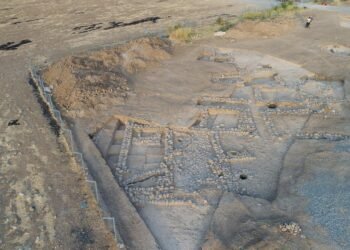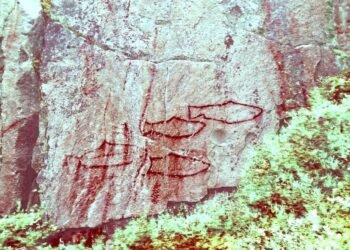A joint Egyptian-American archaeological team has uncovered a significant ancient tomb near Luxor, housing 11 sealed burials, Egypt’s Tourism and Antiquities Ministry reported Friday. The tomb, dating back to the Middle Kingdom (1938 BCE.-1630 BCE), was discovered in the South Asasif necropolis, close to the Temple of Hatshepsut on Luxor’s Nile West Bank.
According to Mohamed Ismail Khaled, Secretary-General of Egypt’s Supreme Council of Antiquities, the tomb served as a family burial site over several generations, likely during the 12th Dynasty and extending into the early 13th Dynasty. Coffins for men, women, and children were found, revealing that the tomb was used across multiple family lines. Khaled noted that ancient floods had destroyed much of the wooden coffins and linen wrappings, yet valuable artifacts managed to survive.
Among the recovered artifacts were finely crafted pieces of jewelry, including a unique necklace with 30 amethyst beads and two cylindrical agate beads flanking a hippo-head amulet, as described by Catherine Blakeney, the lead American archaeologist on the mission. “Such craftsmanship underscores the cultural and artistic sophistication of the Middle Kingdom,” Blakeney commented. Other findings included two copper mirrors, one with a lotus-shaped handle and another adorned with a design of Hathor, the ancient Egyptian goddess associated with the sky, women, fertility, and love.
The head of the Egyptian Archaeological Sector, Dr. Ayman Ashmawi, noted that although floods damaged much of the burial site, objects made from less-perishable materials—like jewelry and certain stone artifacts—remained intact. These items include additional necklaces, bracelets, and figurines, many of which depict animals and deities symbolic to the ancient Egyptians.
After years of political unrest following the 2011 uprising and setbacks from the COVID-19 pandemic, Egypt’s tourism industry has yet to return to its 2010 peak. Egypt’s government is eager to revitalize the industry and has invested heavily in archaeological and heritage projects. As part of these efforts, last month the Grand Egyptian Museum, a massive new complex near the Giza Pyramids, began a trial opening of 12 exhibition halls showcasing Pharaonic artifacts, in anticipation of a full public opening.
This latest find in Luxor reinforces Egypt’s status as a cultural hub, and officials hope that such discoveries will rekindle international interest in the country’s rich archaeological legacy.






















